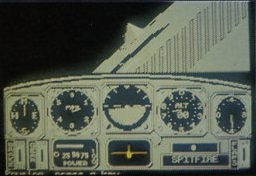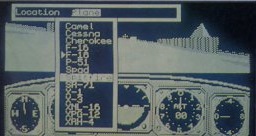

With the long-awaited conversion of Chuck Yeager’s Advanced Flight Trainer just about to be released from Electronic Arts, CRASH investigates General Yeager’s career and talks to the programmer.
At the end of WWII, and the start of the Cold War, jet propulsion was replacing propellors and the race was on to produce the best military jets in the world. The great aviation companies of the US churned out ever weirder aircraft by the month — jets like the tiny Goblin (intended to be carried by bombers until needed for defence) and jets with skis (to land on water). There were no sophisticated computers to predict how the aircraft would fly, and little time for long, slow evaluations. The air base where all these tests happened was Edwards, named after a dead test pilot, and its roads soon became named after yet more test pilots who’d ‘bought the farm’. Simply learning to fly those early, primitive jets was difficult — in 1952, 62 USAF pilots died during just 36 weeks of training — testing them was even more hazardous.
Yet flying at Edwards was not a duty dreaded by its pilots. Quite the reverse, in fact, as writer Tom Wolfe described it in The Right Stuff there was a hierarchy of military pilots — a pyramid. At the bottom were the third or so of trainees who washed out during training, many of whom went on to become back-seat radar operators. Then there were transport plane pilots, and so the hierarchy went until it reached the elite who became fighter pilots. Above them were the pilots who had the skills to be test pilots. And the best of them was Chuck Yeager, whose Southern accent became unconsciously imitated by pilots the world over — like the upwardly-mobile imitating a high class, BBC accent.
Yeager was born into a poor West Virginia family and would, like his father, probably have become a gas driller had it not been for WWII. He enlisted in 1941 at the age of 18, and by 1943 was a flight officer flying P-51 Mustangs over Germany from British bases — despite the fact that on his first few flights he was air sick! In his first eight missions Yeager shot down two German fighters, but on his ninth he was brought down by enemy flak and had to bail out. Fortunately he was picked up by the French resistance and eventually smuggled out to Spain. After that he should’ve gone home — in case he was shot down again and tortured to reveal the names of Resistance members. But Yeager fought this policy all the way up to General Eisenhower, and was eventually allowed into combat again.

Pyramids are just one of the landscape features to admire — if you stay aloft long enough
Despite promising to marry ‘Glamorous Glennis’, a beautiful brunette, he’d met back in the States, Yeager was determined to have a good time while ‘there were still a few girls to chase, a few bottles left undrunk, and more than likely a few Krauts to shoot at.’* If a pilot friend died, they just drunk a little more. Thirteen pilots had died simply during basic training. But the excitement of battle proved addictive, it was ‘the ultimate flying experience’. ‘It’s almost impossible to describe the feeling: it’s as if you were one with that Mustang, an extension of the throttle... You were so wired into that airplane that you flew it to the limit of its specs, where firing your guns could cause a stall... Maximum power, lift, and manoeuvrability were achieved mostly by instinctive flying... Concentration was total... (Once) you set him... there was no way out... You picked your spot: slightly below, so you could pull up, lead him a little, and avoid being hit by metal when he disintegrated... There was no joy in killing someone, but real satisfaction when you outflew a guy and destroyed his machine.’*
By the end of the war, Yeager had thirteen and a half kills, including a Messerschmitt-262 jet. You’d expect after that he might want a quieter life, and indeed he asked to be assigned to an air base as close to home as possible. That base was Wright Field, Ohio, and it was crammed with aircraft waiting to be test flown. Yeager didn’t apply to be a test pilot, he lacked the academic background, but instead became an assistant maintenance officer — in charge of checking out repaired aircraft. Yet ironically, because the early jets were so unreliable, Yeager spent more time flying them than the test pilots. Later he would fly one of the jets at air displays, and because of his mechanical knowledge could fix the planes and bring them back. Most pilots left their inevitably malfunctioning aircraft at the air show. This came to the attention of the head of the flight test division. When he was offered the opportunity of becoming a test pilot Yeager didn’t hesitate.
Just a few months after he graduated from the test pilots’ school he was selected to be the prime pilot for the X-1 project. At that time there were plenty of scientists and engineers who believed no aircraft would be able to fly faster than the speed of sound — the shockwaves would destroy any aircraft. In 1947 a famous British test pilot, Geoffrey De Havilland Jr. had died when his aircraft had disintegrated in a dive trying to break the barrier. As a result the British had closed down their supersonic experiments.
The American project to beat the sound barrier was the X-1. This was a small aircraft designed to be carried aloft by a B-29 bomber, then dropped at altitude and the rocket engines ignited. It was shaped like .50 calibre machine-gun bullet since this was a shape known to be stable at supersonic speeds. The aircraft had been been built by the Bell Corporation and it was they who were paying a civilian test pilot to fly it. At that time it wasn’t thought right to ask a military pilot to take the risks for his normal wages. But the civilian pilot involved, Slick Goodlin, had only contracted to take the X-1 to .8 Mach (80% of the speed of sound). To go further he wanted $150,000, which Bell refused to pay. Annoyed by the delays the air force stepped in with Yeager and Co.
Apart from a bit of high spirits on the first flight — dropping down to 100 metres above the runway and igniting the main engines — the programme proceeded smoothly enough. And an inevitable part of the routine was Pancho’s, a local bar frequented mainly by test pilots. According to Wolfe ‘Flying & Drinking, Drinking & Driving’ were part of the military tradition. But since Muroc was so primitive, horses took the place of cars.
On the night before the big supersonic flight Yeager went for a race with his wife, Glennis. Of course Yeager fell, but rather than report to an air force doctor he went to a nearby town where a local doctor strapped up two broken ribs and told him to avoid moving his right arm for two months.
Nevertheless Yeager had his wife drive him to the air base. He got a friend to give him a stick to close the cockpit door, and the mission began...
... The B-29 takes off and at seven thousand feet Yeager climbs down through the bomb-bay into the X-1. At 26,000 feet the B-29 goes into a dive, then pulls up and releases the X-1 so that it sails upwards like a tossed bomb. The rockets ignite and the X-1 zooms upwards at a 45° angle. At Mach .87 severe buffeting begins, but Yeager keeps on and soon after the machometer needle goes off the scale and a sonic boom echoes over the desert.
It was five months or so however, before the news was made public and Yeager received practically every aviation award going. By that time he’d gone on to testing other vehicles. He flew the USAF’s first swept-wing bomber, the B-47, and helped teach the Strategic Air Command how to do air-to-air refuelling. In 1954 he test flew a defector’s MiG-15 — the Russians’ prime weapon in the Korean War — in tropical storms to provide some extremely valuable information. During the mid-Fifties he was in Germany, training F-86 fighter squadrons how to do quick alerts. In 1962 he was Commandant of the school where military pilots were trained to be astronauts. During the Vietnam war he flew 127 combat missions, and went on to reach the rank of brigadier general before retiring. But he still flies supersonic aircraft, for the sheer fun.
Chuck Yeager’s Advanced Flight Trainer is a unique game in that it’s designed to allow players to test a wide range of aircraft against specifications included in the manual, simulating the work of a test pilot. The first level of the solid 3-D game teaches basic flying skills such as take-offs and landing, while the second introduces more advanced rnanoeuvres like power off stalls. The third level teaches acrobatic stunts and obstacles courses, and like all the other levels features instructions from Yeager. On 128K machines there will also be the capability to do formation flying and race a computer-controlled aircraft.

Some of the planes you can fly (or crash, in most cases)
The 14 aircraft waiting in the hangers cover a wide range; there’s light civilian aircraft (the Cessna 172 and Cherokee), WWI biplanes (the Sopworth Camel and Spad XIII), WWII fighters (the Spitfire and P-51 Mustang), modem combat jets (the F-16 and F-18), experimental jets (the X-1, X-3 and unbuilt XPG-12, XRI-I-4 and XNL-16) and even the world’s fastest reconnaissance jet; the SR-71 Blackbird. These are all simulated with great attention to detail, with the SR-71 taking forever to make a turn and the X-1 being rather difficult to make take-offs in.
All the flying takes place over a wraparound, solid 3-D landscape including features such as pyramids, tower blocks swamps and, of course, two runways. Making a rather large hole in said landscape is made easier by red-outs and blackouts; when G-forces make you lose consciousness blanking out the screen. There’s also the possibility of you getting locked into some fatal spins!
The programming of the Z80 versions of Chuck Yeager’s Advanced Flight Trainer was begun about eight months ago by Stefan Walker, a twenty-year-old whose first job was with MicroProse in the USA. After writing Z80 versions of Pirates there, and doing some work on Project: Stealth Fighter, Stefan returned to Britain to work for Electronic Arts. AFT is his first game for them and is a conversion of the Apple game (previously the most recent version of the program).
The bulk of the Z80 program was written on the Amstrad, with most of the code, except the graphics, being ported across to the Spectrum game. The Amstrad version runs about two frames faster than the relatively-quick C64 game, and the Spectrum a touch faster still. This means a lot more realism, requiring even quicker responses.
Chuck Yeager’s Advanced Flight Trainer should be out soon for £8.95 on cassette, and £14.95 on disk.
The above feature was written with reference to two great books. Firstly there’s The Right Stuff, Tom Wolfe’s brilliant account of the early days of the US manned space programme with two chapters on General Yeager. Then there’s Yeager’s own action-packed autobiography simply called Yeager written with Leo Janus. All quotes, signified by *, are excerpts from Yeager.